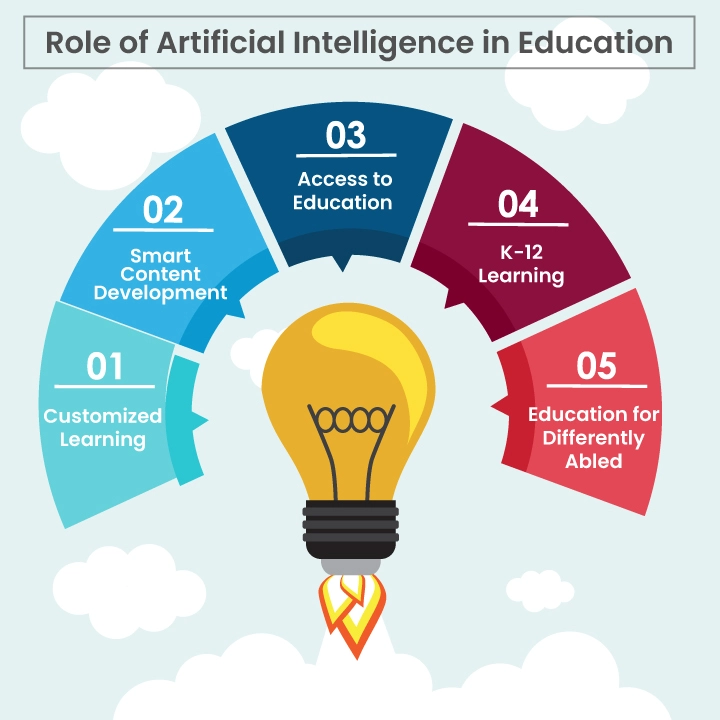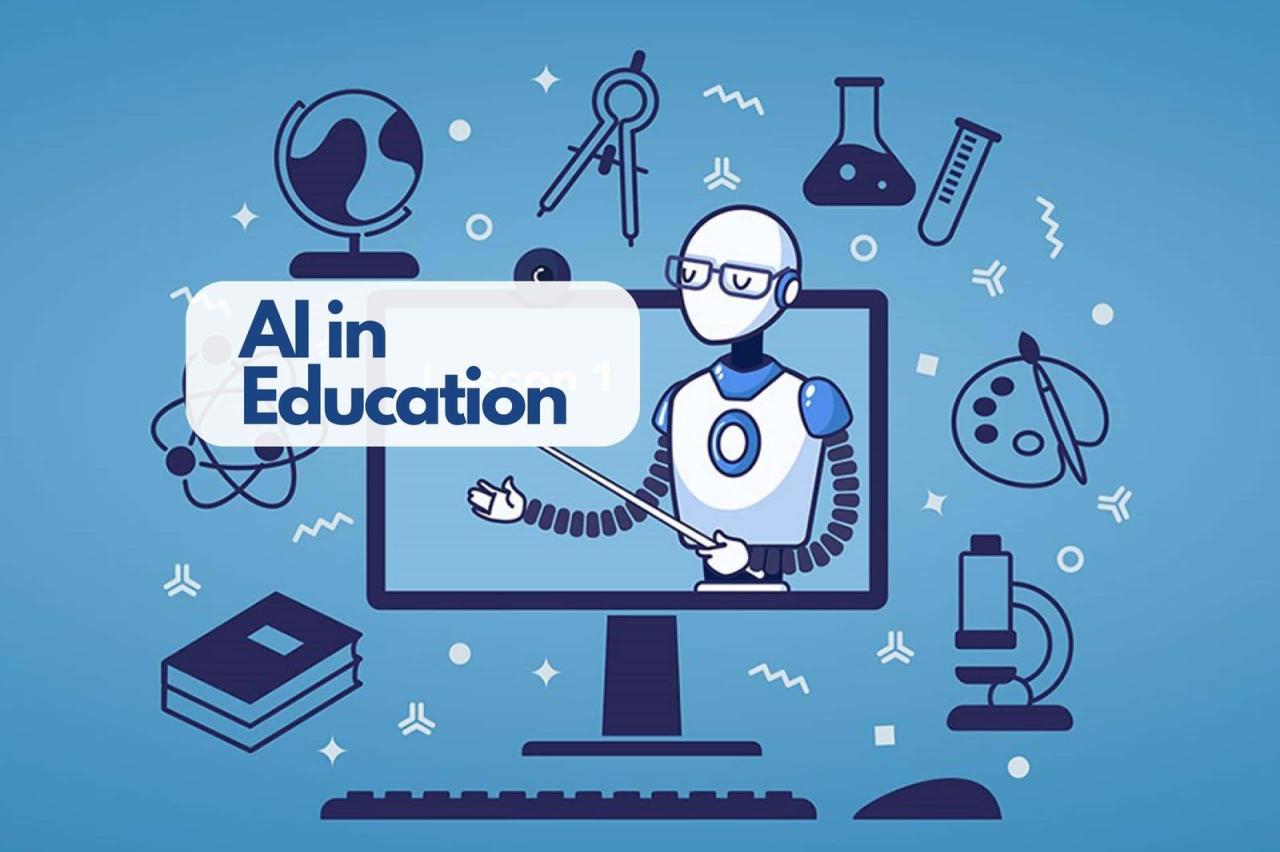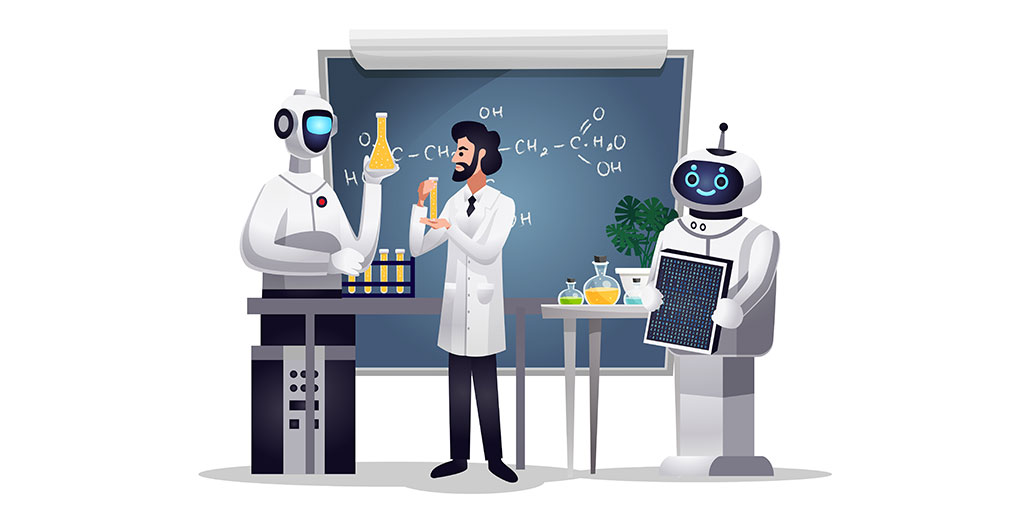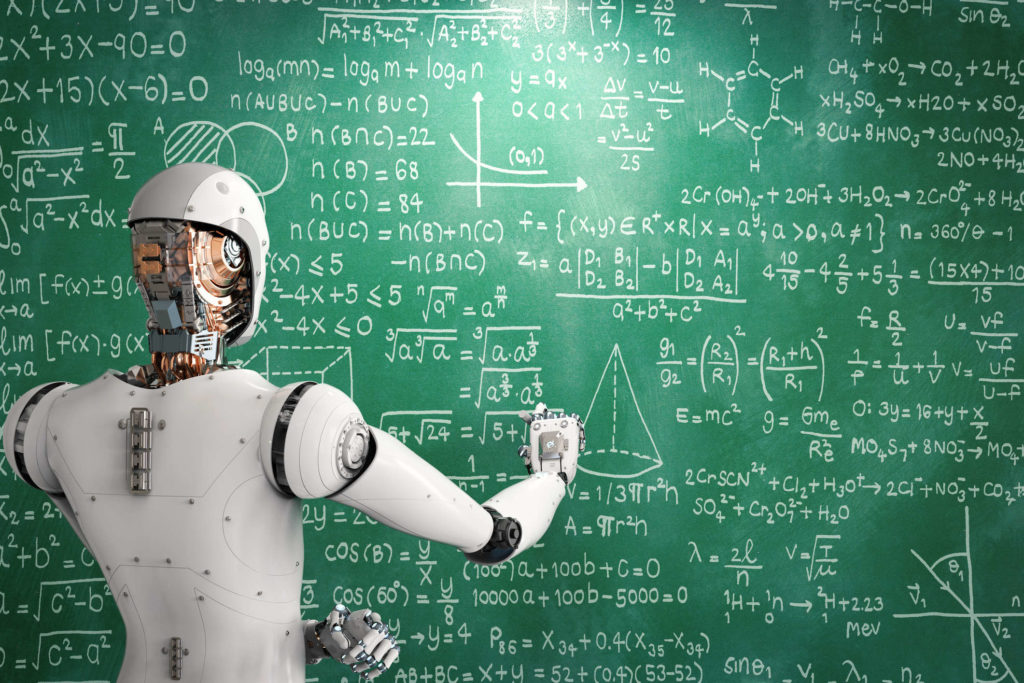AI in education is no longer a futuristic fantasy; it’s rapidly transforming how we learn and teach. From personalized learning platforms that adapt to individual student needs to AI-powered assessment tools that provide instant feedback, the integration of artificial intelligence is reshaping the educational landscape. This exploration delves into the exciting possibilities and challenges of this technological revolution, examining its impact on students, teachers, and the future of education itself.
We’ll dissect the various applications of AI in education, from automating grading and providing personalized learning experiences to addressing ethical concerns and enhancing accessibility for students with disabilities. We’ll also look at how AI is poised to revolutionize teacher training and professional development, empowering educators to leverage technology for optimal learning outcomes. Prepare for a deep dive into the world of AI and its profound influence on the future of learning!
AI-Powered Learning Platforms

The integration of artificial intelligence (AI) into education is rapidly transforming how students learn and educators teach. AI-powered learning platforms are at the forefront of this revolution, offering personalized learning experiences, automated feedback, and data-driven insights that enhance the overall educational process. These platforms leverage various AI technologies, including machine learning and natural language processing, to create dynamic and adaptive learning environments.AI-Powered Learning Platforms: Features, Target Audiences, and Pricing ModelsThe following table highlights the key features, target audiences, and pricing models of three prominent AI-powered learning platforms.
These platforms represent a range of approaches and cater to diverse educational needs.
| Platform Name | Key Features | Target Audience | Pricing Model |
|---|---|---|---|
| Khan Academy | Personalized learning paths, adaptive exercises, video lessons, progress tracking, gamified learning elements. Utilizes AI to identify student knowledge gaps and recommend appropriate learning materials. | K-12 students, lifelong learners | Free (with optional donations) |
| Duolingo | AI-powered language learning, personalized lessons based on user progress, gamified learning, speech recognition, and AI-driven feedback on pronunciation. | Language learners of all levels | Freemium model (free version with limited features, paid subscription for full access) |
| Century Tech | AI-driven assessment and personalized learning pathways, identifies student strengths and weaknesses, provides teachers with actionable insights, adaptive learning content. | K-12 schools and institutions | Subscription-based, pricing varies depending on the number of students and features. |
Pedagogical Approaches Employed by AI-Powered Learning PlatformsThese platforms employ various pedagogical approaches, often incorporating elements of personalized learning, adaptive learning, and gamification. Khan Academy, for instance, utilizes a mastery-based learning approach, focusing on ensuring students achieve proficiency in each concept before moving on. Duolingo leverages spaced repetition and gamification to keep learners engaged and motivated. Century Tech focuses on data-driven instruction, providing teachers with insights to tailor their teaching to individual student needs.
AI in education is revolutionizing learning, offering personalized experiences and efficient assessment tools. Imagine a student’s home study space, complete with a comfortable chair and a stylish end tables for living room to hold their tablet or laptop. This setup perfectly complements the enhanced learning opportunities provided by AI, creating a more effective and enjoyable learning environment for students of all ages.
These platforms adapt their content and pace based on individual student performance, providing targeted support where needed.AI-Driven Personalized Learning versus Traditional Classroom Instruction: A ComparisonAI-driven personalized learning offers several advantages over traditional classroom instruction. It allows for individualized pacing, catering to students who learn at different speeds. It provides targeted feedback and support, addressing specific learning gaps. The adaptive nature of these platforms ensures students are constantly challenged and engaged.
However, traditional classrooms offer the benefits of social interaction and collaboration, which are crucial for developing social-emotional skills. Furthermore, the human element of a teacher’s guidance and mentorship remains invaluable, especially for complex concepts or emotional support. The ideal approach likely involves a blended learning model, combining the strengths of both AI-powered platforms and traditional classroom instruction.
AI in education is revolutionizing learning, offering personalized experiences and efficient assessments. But even the most advanced AI-powered classroom needs a comfortable setting, and that starts with the right ambiance; consider investing in beautiful curtains for living room to create a calming and focused environment for students at home. Ultimately, a supportive learning space, both digitally and physically, enhances the effectiveness of AI tools in education.
For example, a teacher might use an AI platform to deliver personalized practice exercises while reserving class time for discussions, group projects, and direct instruction on complex topics. The effectiveness of either approach depends on various factors, including the student’s learning style, the subject matter, and the quality of instruction.
AI in Assessment and Feedback

The integration of artificial intelligence (AI) in education is rapidly transforming how we assess student learning. Moving beyond traditional methods, AI offers automated grading, personalized feedback, and insights into student performance that were previously unimaginable. This shift promises to enhance efficiency and provide educators with more time to focus on individual student needs. However, it’s crucial to consider the ethical implications and potential biases inherent in these systems.AI employs various methods to automate the grading process, significantly reducing the workload on educators.
These methods range from simple matching algorithms for multiple-choice questions to sophisticated natural language processing (NLP) techniques for evaluating essays and coding assignments. The complexity of the AI system depends on the type of assessment.
Automated Grading Methods
AI leverages several techniques for automated grading. For objective questions like multiple-choice or true/false, AI can instantly compare student answers to the correct answers, providing immediate scores. For subjective assessments such as essays, AI utilizes NLP to analyze grammar, syntax, vocabulary, and even the overall argument presented. This analysis helps determine the quality of the writing and assign a score based on pre-defined criteria.
In coding assignments, AI can automatically run the student’s code, test it against various inputs, and assess its functionality and efficiency. Machine learning models are trained on vast datasets of graded assignments to improve their accuracy over time.
Advantages and Disadvantages of AI-Driven Assessment, Ai in education
AI-driven assessment offers several advantages, including increased efficiency and scalability. Automated grading saves educators significant time, allowing them to focus on more personalized instruction and student interaction. AI can also provide immediate feedback to students, promoting faster learning and self-improvement. Furthermore, AI can analyze large datasets of student work to identify learning gaps and areas where curriculum adjustments might be beneficial.
However, concerns regarding fairness and bias in AI systems are valid. AI models are trained on data, and if this data reflects existing biases, the AI system will likely perpetuate and even amplify these biases in its assessments. For instance, an AI system trained on essays primarily written by native English speakers might unfairly penalize students whose first language is not English.
Another concern is the potential for over-reliance on AI, leading to a reduction in human interaction and a diminished emphasis on the nuanced aspects of student learning that are difficult to quantify algorithmically. The lack of transparency in some AI systems also poses a challenge, making it difficult to understand how the AI arrives at its assessments.
Example: AI-Powered Assessment System for History
Imagine an AI-powered assessment system for a high school history class focused on the American Civil War. This system could incorporate multiple assessment types. Multiple-choice questions would be automatically graded, providing immediate feedback on factual knowledge. Essay questions, requiring students to analyze primary source documents and synthesize information, would be assessed using NLP. The AI would analyze the essay’s argumentation, historical accuracy, and use of evidence, providing detailed feedback on areas for improvement.
The system could also include interactive map exercises where students identify key battle locations and analyze their strategic significance. The AI would track student performance across different assessment types, identifying strengths and weaknesses, and generating personalized learning recommendations. This system would provide students with immediate feedback and identify learning gaps, allowing the teacher to tailor instruction to meet individual needs.
The system could also provide valuable data on class-wide understanding, allowing the teacher to adjust their teaching methods accordingly.
AI for Personalized Learning Experiences

AI is revolutionizing education, moving beyond the one-size-fits-all approach to learning and embracing personalized experiences tailored to individual student needs. This shift leverages the power of artificial intelligence to adapt to diverse learning styles, paces, and knowledge gaps, ultimately fostering more effective and engaging learning journeys.AI algorithms achieve personalization by analyzing vast amounts of student data, including learning history, performance on assessments, and even engagement patterns.
This data informs the AI’s understanding of each student’s strengths, weaknesses, and preferred learning methods. Through sophisticated machine learning techniques, the AI dynamically adjusts the learning path, content delivery, and difficulty level to optimize the learning process for each individual.
AI Adaptation to Individual Learning Styles and Paces
AI-powered learning platforms can identify a student’s preferred learning style—visual, auditory, kinesthetic, or a combination—by tracking their engagement with different types of content. For example, if a student consistently performs better on activities involving interactive simulations, the AI can prioritize similar activities in future learning modules. Similarly, the AI can adjust the pace of learning based on a student’s progress.
If a student quickly grasps a concept, the AI can accelerate the learning process; conversely, if a student struggles, the AI can slow down the pace, provide additional support, and offer different explanations or examples. This adaptive approach ensures that students are neither bored by slow-paced instruction nor overwhelmed by rapid progression.
AI Identification of Learning Gaps and Targeted Interventions
AI excels at identifying learning gaps. By analyzing student responses to quizzes, assignments, and even in-class activities, the AI can pinpoint specific areas where a student is struggling. This allows for immediate and targeted interventions. For instance, if the AI detects that a student consistently makes errors in solving quadratic equations in a mathematics course, it can automatically provide additional practice problems, supplementary video tutorials, or personalized feedback focusing on that specific skill.
This precision ensures that students receive support exactly where they need it, preventing small knowledge gaps from escalating into significant learning difficulties.
AI Personalization Improves Student Outcomes: A Case Study in Algebra
Imagine a high school algebra class using an AI-powered learning platform. Sarah, a student who struggles with word problems, is assigned personalized exercises that focus on translating word problems into algebraic equations. The AI system adapts to her pace, providing additional support and hints when needed. Meanwhile, David, a student who grasps concepts quickly, is presented with more challenging problems and advanced topics, keeping him engaged and preventing boredom.
- Step 1: Diagnostic Assessment: The AI administers an initial assessment to gauge each student’s understanding of fundamental algebraic concepts.
- Step 2: Personalized Learning Path: Based on the assessment, the AI creates a customized learning path for each student, adjusting the difficulty and pace accordingly.
- Step 3: Targeted Interventions: The AI identifies specific areas where students struggle (e.g., solving quadratic equations, interpreting graphs) and provides targeted practice exercises and supplemental materials.
- Step 4: Adaptive Feedback: The AI provides immediate and personalized feedback on student work, helping them understand their mistakes and learn from them.
- Step 5: Progress Monitoring: The AI continuously monitors student progress and adjusts the learning path as needed to ensure optimal learning outcomes.
As a result of this personalized approach, both Sarah and David show significant improvement in their algebra skills, surpassing their performance in previous years. Sarah’s confidence increases as she masters word problems, while David’s enthusiasm for algebra is maintained through challenging and engaging content. This demonstrates the potential of AI to create more equitable and effective learning experiences for all students, regardless of their individual learning styles or paces.
Ethical Considerations of AI in Education

The integration of artificial intelligence (AI) into education offers transformative potential, but it also raises significant ethical concerns that demand careful consideration. Failing to address these issues could lead to inequitable outcomes and undermine the very benefits AI promises. Transparency, fairness, and responsible implementation are paramount to ensuring AI serves as a force for good in education.AI systems, particularly those used for assessment and personalized learning, are trained on vast datasets.
These datasets often reflect existing societal biases, leading to AI tools that perpetuate and even amplify these biases. For instance, an AI system trained primarily on data from high-performing schools might unfairly disadvantage students from under-resourced backgrounds.
Bias Mitigation in AI Educational Tools
Addressing bias requires a multi-pronged approach. First, careful curation of training datasets is crucial. This involves actively seeking diverse and representative data to minimize skewed outcomes. Second, algorithms themselves need to be designed with fairness in mind. Techniques like fairness-aware machine learning can help mitigate bias during the model training process.
Finally, regular auditing and evaluation of AI systems are necessary to identify and correct biases that may emerge over time. This ongoing monitoring ensures the AI remains equitable and effective for all learners. For example, a platform using AI for essay grading should be regularly checked to ensure it doesn’t penalize students for variations in writing style that don’t reflect a lack of understanding.
Implications of AI on Teacher Roles and Responsibilities
The role of teachers is not being replaced by AI, but rather evolving. AI tools can automate administrative tasks, freeing up teachers to focus on more impactful activities like personalized instruction and student mentorship. However, teachers need to develop new skills to effectively integrate and manage AI tools in their classrooms. This includes understanding how these tools work, identifying potential biases, and critically evaluating the insights they provide.
The teacher’s role shifts from solely delivering information to guiding and facilitating learning, leveraging AI as a powerful assistant. For example, teachers might use AI to identify struggling students and then tailor their interventions accordingly.
Data Privacy and Security in AI-Powered Educational Environments
Protecting student data is paramount. AI systems in education collect and process sensitive information, making data privacy and security critical considerations. Robust security measures, including encryption and access controls, are essential to prevent unauthorized access and data breaches. Furthermore, transparent data governance policies are needed, clearly outlining how student data is collected, used, and protected. Compliance with relevant data privacy regulations, such as FERPA in the US and GDPR in Europe, is non-negotiable.
Institutions must also educate students and parents about data privacy practices and obtain informed consent for data collection and use. This includes being transparent about how AI tools utilize student data to personalize learning experiences.
The Role of AI in Teacher Training and Professional Development: Ai In Education
AI is rapidly transforming various sectors, and education is no exception. Its potential to revolutionize teacher training and professional development is particularly exciting, offering personalized learning pathways and efficient upskilling opportunities previously unimaginable. By leveraging AI’s capabilities, educators can enhance their skills, adapt to evolving pedagogical approaches, and ultimately improve student learning outcomes.AI can significantly enhance teacher training programs by providing personalized and adaptive learning experiences.
This contrasts sharply with traditional, one-size-fits-all approaches. Instead of generic training modules, AI can tailor content and pacing to individual teacher needs, focusing on areas requiring improvement and accelerating learning in areas of strength. This personalized approach maximizes efficiency and ensures that teachers acquire the specific skills they need to succeed in their classrooms.
AI-Powered Personalized Professional Development
AI facilitates personalized professional development by analyzing teacher performance data, identifying skill gaps, and recommending relevant resources. For instance, an AI system could analyze a teacher’s lesson plans, student assessment data, and classroom observations to pinpoint areas where improvement is needed. Based on this analysis, the system can then suggest specific online courses, workshops, or mentoring opportunities tailored to the teacher’s individual needs.
This targeted approach ensures that professional development efforts are effective and directly address the challenges faced by individual educators. Imagine a system identifying a teacher struggling with incorporating technology effectively into their lessons; the AI could then suggest relevant online courses focusing on specific software or pedagogical techniques.
Sample Curriculum for an AI-Focused Professional Development Workshop for Teachers
This workshop aims to equip teachers with the knowledge and skills necessary to effectively integrate AI tools into their teaching practices. The curriculum focuses on practical application and addresses potential ethical concerns.
- Introduction to AI in Education: This module will provide a foundational understanding of AI concepts and their applications in education, focusing on demystifying the technology and highlighting its potential benefits. Examples of successful AI implementations in education will be presented.
- AI-Powered Assessment and Feedback Tools: This section will explore various AI tools available for automated assessment and personalized feedback. Participants will learn how to use these tools to streamline grading, provide targeted feedback, and identify student learning gaps more efficiently. Specific examples of platforms and their functionalities will be demonstrated.
- AI for Personalized Learning: This module will delve into the use of AI to create personalized learning experiences for students. Teachers will learn how to leverage AI-powered platforms to adapt instruction to individual student needs, pacing, and learning styles. Case studies showcasing successful implementations of personalized learning will be discussed.
- Ethical Considerations of AI in Education: This crucial section will address the ethical implications of using AI in education, including issues of data privacy, algorithmic bias, and equitable access. Participants will engage in discussions and activities aimed at promoting responsible and ethical use of AI in their classrooms.
- Practical Application and Project Work: Participants will engage in hands-on activities, applying the knowledge gained throughout the workshop to develop lesson plans and activities incorporating AI tools. They will also work on a project to design an AI-enhanced learning experience for their own students.
AI and Accessibility in Education
AI is revolutionizing education, and one of its most impactful applications lies in enhancing accessibility for students with diverse learning needs. By leveraging AI’s capabilities, educational institutions can break down barriers and create a more inclusive learning environment for all students, regardless of their abilities or disabilities. This includes providing personalized support, adaptive learning tools, and assistive technologies that cater to individual requirements.AI’s ability to personalize learning experiences extends significantly to accessibility.
Traditional one-size-fits-all approaches often fail to meet the diverse needs of students with disabilities. AI, however, offers the potential to tailor educational content and delivery methods to individual learning styles and abilities, ensuring that every student can access and engage with the curriculum effectively.
AI-Powered Tools for Diverse Learners
AI-powered tools are transforming how students with disabilities access and engage with education. These tools utilize various technologies to overcome learning challenges and promote inclusivity.
For example, text-to-speech software, powered by AI, can convert written text into audio, benefiting students with visual impairments or dyslexia. Similarly, speech-to-text software allows students with physical limitations to input their responses verbally. AI-driven translation tools can facilitate communication and understanding for students who are learning a new language or have language-based learning disabilities. Furthermore, AI can analyze student performance data to identify learning gaps and automatically adjust the difficulty level of assignments, providing personalized support for students struggling with specific concepts.
Examples of AI-Based Assistive Technologies
Several AI-powered tools are already making a significant impact on accessibility in education. One example is virtual assistants that can answer students’ questions, provide reminders about assignments, and offer personalized support. AI-powered screen readers provide auditory descriptions of visual content, enhancing accessibility for visually impaired students. Adaptive learning platforms use AI to adjust the pace and difficulty of learning materials based on individual student performance, accommodating varying learning speeds and abilities.
These platforms also provide personalized feedback and support, ensuring that students receive the help they need to succeed.
Visual Representation of AI’s Impact on Accessibility
Imagine a vibrant, inclusive classroom. Students with various disabilities are actively engaged in learning. A visually impaired student uses an AI-powered screen reader to access digital textbooks, while a student with dyslexia benefits from AI-powered text-to-speech software. Another student with limited mobility uses AI-powered speech-to-text software to participate in class discussions. The teacher uses AI-driven analytics to understand individual student needs and adjust teaching methods accordingly.
The classroom environment is dynamic and responsive, adapting to the unique learning styles and abilities of each student, all thanks to the integration of AI. This represents a significant shift from traditional, often inaccessible, learning environments. AI fosters an inclusive atmosphere where all students have equal opportunities to succeed.
The Future of AI in Education
The integration of artificial intelligence (AI) in education is still in its nascent stages, yet its potential to revolutionize learning is undeniable. We’re moving beyond the initial experimentation phase, and the next decade promises a dramatic reshaping of the educational landscape, driven by increasingly sophisticated AI applications. This evolution will bring both exciting opportunities and significant challenges that need careful consideration.
The rapid advancements in AI, particularly in machine learning and natural language processing, are fueling this transformation. We can anticipate AI becoming increasingly personalized, adaptive, and integrated into every aspect of the educational process, from curriculum design to assessment and feedback.
AI-Driven Personalized Learning Paths
AI will move beyond simple adaptive learning platforms to create truly personalized learning journeys for each student. This will involve sophisticated algorithms analyzing individual learning styles, strengths, weaknesses, and pace, dynamically adjusting the curriculum and providing tailored resources and support. Imagine a system that identifies a student struggling with a particular concept in algebra and automatically provides them with supplementary videos, interactive exercises, and personalized tutoring sessions, all tailored to their specific learning needs and preferences.
This level of individualized attention is currently impossible to achieve at scale with traditional teaching methods.
AI-Enhanced Teacher Support and Professional Development
AI tools will increasingly support teachers, freeing them from administrative tasks and allowing them to focus on individualized student interaction and mentoring. This includes AI-powered systems that automate grading, provide real-time feedback on student progress, and identify students who need extra support. Furthermore, AI can personalize professional development opportunities for teachers, recommending relevant training based on their individual needs and areas for improvement.
For example, an AI system could analyze a teacher’s lesson plans and student performance data to suggest specific workshops or online courses that could enhance their teaching effectiveness.
The Rise of AI-Powered Educational Assistants
In the next 10 years, we can expect the emergence of sophisticated AI-powered educational assistants that act as personalized tutors, providing students with on-demand support and guidance. These assistants will be capable of answering questions, providing explanations, offering feedback, and even generating customized learning materials. Think of it as having a 24/7 tutor available to every student, regardless of their location or socioeconomic background.
This accessibility will significantly improve learning outcomes, particularly for students in underserved communities.
Challenges in AI Integration in Education
The widespread adoption of AI in education faces several significant challenges. Data privacy and security are paramount concerns. Ensuring the ethical use of AI, avoiding bias in algorithms, and maintaining transparency in AI-driven decision-making processes are crucial. The digital divide also poses a significant hurdle, as access to technology and reliable internet connectivity is not universally available.
Finally, the need for teacher training and professional development to effectively integrate AI tools into their teaching practices cannot be overstated. Addressing these challenges will be critical to realizing the full potential of AI in education.
AI Transforming the Educational Landscape in the Next 10 Years: A Scenario
By 2033, imagine a world where personalized learning is the norm. Students access curated learning pathways via AI-powered platforms, receiving real-time feedback and support. Teachers act as mentors and facilitators, guiding students through their individual learning journeys. AI-powered educational assistants provide personalized tutoring and support, bridging learning gaps and ensuring equitable access to high-quality education. Assessment methods have evolved, with AI tools providing richer and more nuanced feedback than ever before.
This transformation will not only improve learning outcomes but also empower students to take ownership of their education and develop essential 21st-century skills.